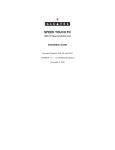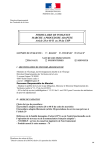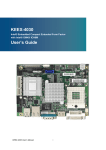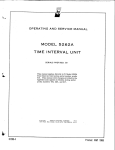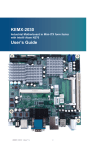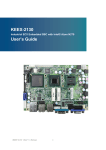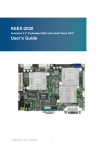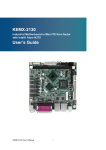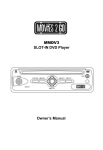Download User's Manual
Transcript
User’s Manual BPC65-B-A16G Copyrights that interference will not occur in a particular installation. If this equipment does cause harmful ©2009. All rights reserved. The information in this interference to radio or television reception, which document is subject to change without prior notice in order to improve reliability, design and function and does not represent a commitment on the part of the manufacturer. can be determined by turning the equipment off and on, the user is encouraged to try to correct the interference by one or more of the following measures: This document contains proprietary information • Increase the separation between the equipment protected by copyright. All rights are reserved. No and the receiver. part of this manual may be reproduced by any • Connect the equipment into an outlet on a circuit mechanical, electronic, or other means in any form different from that to which the receiver is connected. without prior written permission of the manufacturer. • Consult the dealer or an experienced radio or television technician for help. All trademarks are property of their respective This device complies with Part 15 (B) of the FCC owners Rules. Operation is subject to the following two conditions: Liability Disclaimer In no event will the manufacturer be liable for direct, indirect, special, incidental, or consequential damages arising out of the use or inability to use the product or documentation, even if advised of the possibility of such damages. FCC Notices 1) this device may not cause harmful interference and 2) this device must accept any interference received, including interference that may cause undesired operation. NOTE: THE MANUFACTURER IS NOT RESPONSIBLE FOR ANY RADIO OR TV INTERFERENCE CAUSED BY UNAUTHORIZED MODIFICATIONS TO THIS DEVICE. SUCH MODIFICATIONS COULD VOID THE USER'S AUTHORITY TO OPERATE THE DEVICE. This equipment has been tested and found to comply with the limits for a Class B digital device, pursuant to Part 15 of the Federal Communications Commission (FCC) Rules. These limits are designed to provide CE Notice reasonable protection against harmful interference in a residential installation. This equipment generates, uses, and can radiate radio frequency energy and, if not installed and used in accordance with the instructions, may cause harmful interference to radio communications. However, there is no guarantee Copyrights This device complies with EMC Directive 2004/108/EC issued by the Commission of the European Community. i WEEE Notice The WEEE mark applies only to countries within the European Union (EU) and Norway. This appliance is labeled in accordance with European Directive 2002/96/EC concerning waste electrical and electronic equipment (WEEE). The Directive determines the framework for the return and recycling of used appliances as applicable throughout the European Union. This label is applied to various products to indicate that the product is not to be thrown away, but rather reclaimed upon end of life per this Directive. Safety Notice CAUTION: Danger of explosion if battery is incorrectly replaced. Replace only with the same or equivalent type recommended by the manufacturer. Dispose of used batteries according to the manufacturer’s instructions. ii Contents Contents Copyrights .................................................................................................i Liability Disclaimer ...................................................................................i FCC Notices...............................................................................................i CE Notice ...................................................................................................i WEEE Notice.............................................................................................ii Safety Notice ............................................................................................ii Contents...................................................................................................iii 1. Hardware Setup....................................................................................1 1.1. Unpacking the Box....................................................................................... 1 2. Quick Tour ............................................................................................2 2.1. Front View..................................................................................................... 2 2.2. Rear View ...................................................................................................... 2 2.3. Peripherals Installation................................................................................ 3 Power Adapter.........................................................................................................................3 USB Mouse, USB Keyboard and USB ODD .........................................................................3 VGA LCD Touchscreen Monitor (WTM/TM Series Recommended) ...................................4 2.4. Turn on the Device ....................................................................................... 5 3. Basic Driver Installation ......................................................................6 3.1. Before the installation.................................................................................. 6 3.2. Chipset Software Installation ...................................................................... 6 3.3. VGA Driver Installation ................................................................................ 8 3.4. Touch Screen Driver and Software Utility installation .............................11 3.4.1. WTM series..................................................................................................................11 3.4.2. TM 550 Touch Monitor................................................................................................14 3.5. LAN Driver Installation............................................................................... 17 4. Touchscreen Control Panel Quick Guide (WTM Series).................19 4.1. Launch Touchscreen V7.5.COM................................................................ 19 4.2. User interface ............................................................................................. 19 4.3. Serial Port Information .............................................................................. 20 4.4. Virtual Button Settings .............................................................................. 20 Virtual Button Option ...........................................................................................................20 Right Button Function..........................................................................................................21 Right Button Automatic Mode .............................................................................................21 4.5. Feedback Sound ........................................................................................ 22 Feedback Sound Option ......................................................................................................22 Tone........................................................................................................................................23 Duration .................................................................................................................................23 4.6. Screen Calibration ..................................................................................... 23 4 points, mode 1....................................................................................................................23 4 points, mode 2....................................................................................................................24 Contents iii How to Use Event Selector ..................................................................................................25 5. Touch Panel Settings (TM Series) ....................................................26 5.1. Start screen of Touch Panel Settings ....................................................... 26 5.2. Hardware set-up ......................................................................................... 27 Single Monitor (Plug and Play Device) ...............................................................................27 Port Setting............................................................................................................................27 Data interval time ..................................................................................................................27 Mouse Cursor Setting ..........................................................................................................27 Dual Monitor (Non-Plug and Play Device)..........................................................................27 Port Setting............................................................................................................................27 Data interval time ..................................................................................................................28 Mouse Cursor Setting ..........................................................................................................28 5.3. Audible feedback set-up............................................................................ 28 Audible feedback setting .....................................................................................................28 5.4. Touch sensitivity set-up ............................................................................ 29 Operate mode........................................................................................................................29 Double-click setting..............................................................................................................30 5.5. Right button simulation ............................................................................. 30 Right click simulation...........................................................................................................30 Display the icon in the task bar tray ...................................................................................31 Display the icon in the Window...........................................................................................31 5.6. Calibration .................................................................................................. 32 Touch Panel controller features ..........................................................................................32 Accuracy required ................................................................................................................32 Calibration .............................................................................................................................32 5.7. Dual Monitor (Non Plug and Play Device Only) ....................................... 35 Use the dual monitor function.............................................................................................35 OS management dual monitor ............................................................................................35 Monitor position setting.......................................................................................................35 Use port .................................................................................................................................35 6. I/O Definition.......................................................................................36 6.1. Power Connector ....................................................................................... 36 6.2. Serial Port 1/2/3/4 ....................................................................................... 36 JP4 COM 1 Power COM1 Signal / Power Selection...........................................................37 JP5/ 6/ 7 COM2/ 3/ 4 Signal / Power Selection ...................................................................37 6.3. VGA Connector........................................................................................... 39 6.4. LAN and USB 1/2........................................................................................ 39 6.5. USB 3/4 ....................................................................................................... 40 7. Specification.......................................................................................41 7.1. The Device .................................................................................................. 41 iv Contents 7.2. The Wall Mount Kit ..................................................................................... 42 7.3. Build-in Dimension .................................................................................... 43 Contents v 1. 1. Hardware Setup 1.1. Unpacking the Box Chapter 1 The Device X 1 Power Adaptor X 1 Power Cord X 1 Driver and Utility CD X 1 1 2. 2. Quick Tour 2.1. Front View 2.2. Rear View The Power indicator will glow green when power is on. The HDD indicator will blink green when the HDD is accessed. 2 Chapter 2 Note: For details of I/O ports on the back panel, please refer to 6. I/O Definition. 2.3. Peripherals Installation Power Adapter Connect the output jack of the adapter to the DC 12V jack on the back panel of the device. USB Mouse, USB Keyboard and USB ODD Connect your USB Mouse, USB Keyboard and USB ODD to USB ports on the back panel of the device. Chapter 2 3 VGA LCD Touchscreen Monitor (WTM/TM Series Recommended) 1. Connect one end of the Serial Port Cable to the COM male port on the back panel of the device, another end to the COM port of your LCD panel. 2. Connect one end of the VGA cable to the VGA female port on the back panel of the device, another end to the VGA port of your LCD panel. LAN Cable Connect one end of RJ-45 LAN cable to the LAN port on the back panel of the device, another end to your internet device. Note: For detail information about WTM/TM series touchscreen monitor, please contact your dealer. 4 Chapter 2 Vertical Stand 2.4. Turn on the Device 1. Make sure all peripherals are connected properly. 2. Press and hold the power switch until the power indicator on the front panel glow green. Chapter 2 5 3. 3. Basic Driver Installation 3.1. Before the installation For CD-ROM onboard model: 1. Insert the driver CD into the onboard CD-ROM drive. The program autoruns and displays the DRIVER BANK screen. 2. Follow the on-screen instructions. For Model without CD-ROM Onboard: 1. Connect an external USB CDROM to the USB power and insert the driver CD and turn on the device. The program autoruns and displays the DRIVER BANK screen. 2. Follow the on-screen instructions. 3.2. Chipset Software Installation 1. On the main screen, click “BOXPC 65 Series”. 2. Click INTEL Chipset Driver. 6 Chapter 3 3. Click Next. 4. Read the License Agreement carefully and click Yes. 4. Click Next. Chapter 3 7 6. Click Finish. 3.3. VGA Driver Installation 1. On the main screen, click “BOXPC 65 Series”. 2. Click VGA Driver. 8 Chapter 3 3. Click VGA Driver for WIN2K/XP. 4. Click Next. 5. Read the License Agreement carefully and click Yes. Chapter 3 9 6. Click Next. 7. Click Next. 8.1. Select restart your computer right now or later, and then lick Finish. 10 Chapter 3 3.4. Touch Screen Driver and Software Utility installation Note: If the touchscreen monitor you used is not WTM or TM series, please refers to the user manual of it for touch screen driver installation. 3.4.1. WTM series The installation procedure shown below is based on Microsoft Windows XP. 1. On the main screen, click “BOXPC 65 Series”. 2. Click “Touch Panel Driver”. 3. Click “Touch Panel Driver for WINXP”. 4. Click “Next” button. Chapter 3 11 5. Click “Browse” to select the location where the driver installed, and then click “Next”. Or you can click “Next” go to next screen directly. 6. Click “Browse” to select the start menu folder, and then click “Next”. Or you can click “Next” go to next screen directly. 6. This screen displays setting information. Click Install to continue 12 Chapter 3 installation. If you would like to change settings, click Back to return to previous screens. 7. During the installation, the following screen will be displayed. 8. The message below shows after the installation was successful. Click "OK" to complete the installation. Chapter 3 13 3.4.2. TM 550 Touch Monitor 1. Click TM70/WTM60/TM550/TM515 Series. 2. Click Touch Driver. 3. Click Touch Driver For TM550/TM515 Series. 14 Chapter 3 4. Click Next. 5. Select an item according to your needs, and then click Next. Click the OK button on the pop-up message. 6. If you want to use Multi-Monitor, check the box and click Next. Chapter 3 15 7. Click Next. 8. Click Next. 9. Click Next. 16 Chapter 3 9 The driver starts to install. 10. Click OK. 3.5. LAN Driver Installation 1. After clicking “BOXPC 65 Series” on the main screen, click RTL8111C Lan Driver. Chapter 3 17 2.1. On the welcome screen, click Next. 2.2. Click Install to begin the installation. 3. Click Finish. 18 Chapter 3 4. 4. Touchscreen Control Panel Quick Guide (WTM Series) Note: If the touchscreen monitor you used is not WTM or TM series, please refers to the user manual of it for touch screen driver operation. 4.1. Launch Touchscreen V7.5.COM 1. Under Microsoft Windows XP, click “start” menu and select “Programs”, under ”Touchscreen V7.5.COM” menu, click “Touchscreen Control Panel V7.5.COM”, the control panel of the program shows. 4.2. User interface a b c d e f g h i Serial Port Display serial port information of the system. Virtual Button Open the virtual button setting dialogue box. Feedback Sound Open the feedback sound setting dialogue box. Power Save Open the power down timer adjustment dialogue box Calibration Switch to calibration screen. Calibration Mode Menu Select the calibration by clicking this drop-down list. Display technical support information. Support Exit Event Selector Chapter 4 Exit the program. Enable right mouse button function. The default of this selector is with the left mouse button selected on. For details about event selector settings, please see “How to Use Event Selector” of Section 5.2. 19 4.3. Serial Port Information Click Serial Port button, the serial port information shows. Click OK to back to the control panel. 4.4. Virtual Button Settings Click Virtual Button button, the dialogue box shows: The selected option will be in black. Virtual Button Option Under Virtual Button Option field, there are four options: ․Stream Mode Under this mode, all mouse button simulation will be disabled. ․Lift off Mode Under Lift off Mode, tapping and holding on the screen equals pressing and holding on the left button of the mouse. ․Touch Down Mode Under Touch Down Mode, one single-tapping equals one left mouse clicking. 20 Chapter 4 ․Drag Drop Mode Drag Drop mode allows you to select an object on the screen by tapping, and then slide the selected object to a new location on the screen, the selected object will be dropped on the new location by releasing the touch. The selected option will be in black. Right Button Function ․Disabled (Off) Select this option, the event selector ․Enable (On) will be disabled and disappear. Select this option, the event selector the left-bottom corner of the screen. will be enabled and show on ․Automatic Mode/Manual Mode Drop-down List If the Drag Drop Mode under Virtual Button Option field is select, the drop-down menu below the Enable (On) option will be enabled. Automatic Mode - Select this option, the Right Button Function will switch to automatic mode and the event selector will be disabled and disappear. Manual Mode - Select this option, the Right Button Function will switch to manual mode and the event selector left-bottom corner of the screen. will be enabled and show on the - Options under Right Button Automatic Mode will be enabled when Manual Mode is selected. The selected option will be in black. Right Button Automatic Mode Toggle On time is the duration between the tapping on the screen and that the right mouse button is “virtually” pressed and held. Chapter 4 21 Release the tapping from screen after toggle-on, the pop-up menu shows. The minimize value is 0.5 and maximum value is 5. This option defines how long the right button function will be off. The minimize value is 0.5 and maximum value is 5. Click the drop-down menu to select On or Off to enable or disable the beep sound effect for toggle-on and toggle off. 4.5. Feedback Sound Click Feedback Sound button, the dialogue box shows: Feedback Sound Option Silence (No Sound) No any sound effect. Touch Down Only When this option is selected, there will be one “beep” sound when tapping on the screen. 22 Chapter 4 Lift Off Only When this option is selected, there will be one “beep” sound when releasing from the screen. Both Touch Down & Lift Off When this option is selected, there will be one “beep” sound when tapping on the screen and releasing from the screen. Tone Drag the bar to adjust the frequency of the sound effect. The minimize value is 200 and maximum value is 5000. Duration Drag the bar to adjust how long the “Beep” sound will be. The minimize value is 10 and maximum value is 50. The selected option will be in black. 4.6. Screen Calibration 1. Click the drop menu next to the Calibration button to select calibration mode. 4 points, mode 1 – rectangular four-point calibration 4 points, mode 2 – rhombic four-point calibration 2. Click Calibration button to enter the calibration screen. 4 points, mode 1 a. The mark shows on the Left-up corner. b. Follow the instruction in green to touch the center of Cross Mark. c. When the instruction turns into yellow, releasing the tapping from the screen. d. Follow the instruction in green to touch the center of Cross Mark. e. Repeat Step 2 – Step4 to finish the calibration procedure. Chapter 4 23 4 points, mode 2 a. The mark shows in the middle of the length of the screen.. b. Follow the instruction in green to touch the center of Cross Mark. c. When the instruction turns into yellow, releasing the tapping from the screen. d. Follow the instruction in green to touch the center of Cross Mark. e. Repeat Step 2 – Step4 to finish the calibration procedure. 24 Chapter 4 3. When the calibration procedure is completed, the message shows: To save the new calibration, click Yes, to restore the old calibration, click No. How to Use Event Selector 1. On the desktop of Windows, click icon. 2. icon change to . 3. Now the tapping is simulating right mouse button clicking. 4. After one tap on the screen, icon change to 5. The tapping resumes to left mouse button clicking Chapter 4 . 25 5. 5. Touch Panel Settings (TM Series) Note: If the touchscreen monitor you used is not WTM or TM series, please refers to the user manual of it for touch screen driver operation. To launch Touch Panel Settings, click Start, click Control Panel, and then double-click icon. Note: The contents of this chapter are extracted from Fujitsu Touch Panel (Serial) Device driver setting manual V1.0L24. “Fujitsu” is the registered trademark of FUJITSU LIMITED. 5.1. Start screen of Touch Panel Settings Single Monitor (Plug and Play Device) 26 Dual Monitor Non-Plug and Play Device Chapter 5 5.2. Hardware set-up Single Monitor (Plug and Play Device) Port Setting The setup can't be changed, because COM is recognized automatically. Data interval time Using slider in the scroll bar, you can change coordinates data interval time of touch panel controller from 10ms to 155ms by 5ms step. Mouse Cursor Setting Delete Cursor check box The display of the mouse cursor is deleted. The special cursor of other application isn't deleted by this setup. Dual Monitor (Non-Plug and Play Device) Port Setting You can add two maximum COM ports. How to add a port: Input three fields of port setting below. And, it is added to the port connected by pushing an "=> Add" button. Chapter 5 27 Notes * Setting change should be effective after the system restart. And you can’t use "Calibration" tab page and "Use port" of "Dual monitor set-up" tab page until system restart. * There is a thing that PC causes defective operation when Port address (I/O address, IRQ number ) not set by Windows is input. * When ports other than COM1-9 are used, input a suitable port number of COM1-9 that is not used instead of actual COM port number. And, set the I/O address and the IRQ number as you wish to use. COM Input the COM port number that the device is connected. I/O Input the I/O address that the device is connected. IRQ Input the IRQ number that the device is connected. Data interval time Using slider in the scroll bar, you can change coordinates data interval time of touch panel controller from 10ms to 155ms by 5ms step. Mouse Cursor Setting Delete Cursor check box The display of the mouse cursor is deleted. The special cursor of other application isn't deleted by this setup. 5.3. Audible feedback set-up Single Monitor (Plug and Play Device) Dual Monitor Non-Plug and Play Device Audible feedback setting Sound enabled check box Sound function is enabled when checked. 28 Chapter 5 Sound when pressed The sound comes out when touch panel is pressed. Sound on release The sound comes out when touch panel is released. Kind of sound drop-down list The sound can be selected from among Beep Sound, Asterisk, Exclamation, Question, Critical Stop, Default Sound, and Standard Sound Note: Please use “Sounds” in the control panel to set the condition of Asterisk, Exclamation, Question, Critical Stop, Default Sound, and Standard Sound. Back to driver default button The sound setting is returned to driver default setting.(Sound disabled, Sound when pressed ,Beep Sound , Frequency:1000Hz , Beep time:50ms) Set it as user default button Present sound settings are preserved as standard setting. Contents preserved are displayed in the column of "User default setting". Set as user default button Back to user default setting according to preserved condition. 5.4. Touch sensitivity set-up Single Monitor (Plug and Play Device) Dual Monitor Non-Plug and Play Device Operate mode Stream mode The coordinates value is continuously output until touch panel turns to off. Point mode Point operation. Turning off is notified immediately after turning on is notified. Even if touch continues at the following, no data is output. Chapter 5 29 Double-click setting The range and the speed to make the system recognize double-clicking can be changed. Moreover, it can be set that double-clicking is prohibited. Setting change is effective after “OK" or "Apply" button is clicked. Note: Settings of the above-mentioned Width, Height, and the Speed also affect to other mice connected with the system. But double-clicking prohibition is only for the touch panel. Double-clicking prohibition check box Disable the double-clicking of the touch panel when checked. Width: The horizontal range recognized as double-clicking is set. 2 - 32 [pixel] Height: The vertical range recognized as double-clicking is set. 2 - 32 [pixel] Speed: The maximum time between clicks recognized as double-clicking is set. 150 - 850[ms] Test: The actual double-click test on displayed icon. Icon display is changed when double-clicking is recognized 5.5. Right button simulation Single Monitor (Plug and Play Device) Dual Monitor Non-Plug and Play Device Right click simulation Enable the right click simulation check box Enable function and activate following items when checked. Ctrl key, Shift key, Alt key Select the cooperative key for right-clicking function. Right click is simulated whilst function key is pressed 30 Chapter 5 Just as the guidance when checked. (The Alt key dose not work with this setting.) Right click happens only once after function key is pressed Just as the guidance when checked. Display the icon in the task bar tray The icon of the mouse style (see figures below) is registered in the task tray and right click simulation works without cooperative key operation when checked. Display the icon in the Window The icon of the mouse style (see figures below) is registered in the desktop and right click simulation works without cooperative key operation when checked. Operation of icon The letter of “L” and “R” of the icon shows a present state. At the “R” state, touch works as right-click once and state turns to “L”. State is changed alternatively by touching icon. Note: When the mouse is set for left-handed, the display of L and R becomes opposite. Chapter 5 31 5.6. Calibration Single Monitor (Plug and Play Device) Dual Monitor Non-Plug and Play Device Touch Panel controller features Use onboard EEPROM to store calibration results Do not check here when EEPROM is not used. Accuracy required Select the calibration point number. At EEPROM less condition, the calibration point number is limited to 9. Calibration Calibration Now button This button executes the calibration program. When “Touch Panel controller features” and “Accuracy required” are changed. Calibration can't be carried out until “OK” and “Apply” button are pushed and a setup is renewed. The calibration is done so that pressed position of touch panel device matches to the display position. When the touch panel driver setup or the touch panel device is exchanged, it is necessary to calibrate. 1) Click Calibration Now button. 2) The calibration screen is displayed (one “+“ mark is displayed on the left up corner ). 3) Push “+“ mark. When a push point was effective, the following "+" mark is displayed. 4) After all “+“ marks are pressed (9 or 20 pieces), screen is changed to “Test screen” automatically. Notes When you change the port setting in the “Hardware set-up” tab, the calibration program can't 32 Chapter 5 be carried out till system restarts. Calibration screen Key input at calibration screen [Home] [Esc] [Arrow keys] [Enter] Cancel calibration data and skip to test screen. Cancel calibration data and close calibration program. Move the calibration point mark. Revise the calibration data and skip to test screen. Test screen You can do free drawing in this screen so that the result of the calibration can be judged by watching pen input position and displayed position. Drawing test screen where key box is used Key box input of this drawing test screen Chapter 5 33 Calib screen Back to calibration screen. Cursor on/off On and off the cursor display on the screen. CLR screen Update Clear the screen. Close the calibration program. Close the key box window, and screen changes to the style below. Key input of this drawing test screen [Home] [Tab] [Delete] [Insert] [Enter] 34 Back to calibration screen. On and off the cursor display on the screen. Clear the screen and key guidance part moves up and down. The key box is displayed and screen changes into the first style. Close the calibration program. Chapter 5 5.7. Dual Monitor (Non Plug and Play Device Only) Use the dual monitor function Check here when you wish to use dual monitor function. OS management dual monitor Select whether it is OS management dual monitor or video card management dual monitor. Monitor position setting Drag the picture of monitor 1 and 2, and set the position same as actual monitor arrangement. Monitor 1 Select the resolution of monitor1. Monitor 2 Select the resolution of monitor2. Use port Monitor 1 Click the drop-down list to select the port of the touch panel set up on monitor1. Monitor 2 Click the drop-down list to select the port of the touch panel set up on monitor2. Notes Dual monitor set-up screen isn't shown with a PNP touch panel for Widnows95/98/Me/2000/XP. When you change the port setting in the “Hardware set-up” tab, “Use port” can't be changed till system restarts. Chapter 5 35 6. 6. I/O Definition Please refer the detailed technical information about all I/O ports as followings. 6.1. Power Connector Pin 1 2 3 Signal Name NC +12V GND 6.2. Serial Port 1/2/3/4 Pin 36 Signal 1 DCD, Data carrier detect 2 RXD, Receive data 3 TXD, Transmit data 4 DTR, Data terminal ready 5 GND, ground 6 DSR, Data set ready 7 RTS, Request to send 8 CTS, Clear to send 9 RI, Ring indicator Chapter 6 JP4 COM 1 Power COM1 Signal / Power Selection Jumper Setting 1 2 Function 1-3 Short Pin 1 of COM1 = +12V 3-5 Short Pin 1 of COM1 = +5V 5-7 Short Pin 1 of COM1 = +5V 7-9 Short Pin 1 of COM1 = DCD@RS232, TX-@RS422, DATA-@RS485 (Default) 2-4 Short Pin 9 of COM1 = +12V 4-6 Short Pin 9 of COM1 = +5V 6-8 Short Pin 9 of COM1 = +5V 8-10 Short Pin 9 of COM1 = RI (Default) Pitch: 2.54mm [YIMTEX 3322*05SAGR(6T] JP5/ 6/ 7 COM2/ 3/ 4 Signal / Power Selection Jumper Setting 1 2 Function 1-3 Short Pin 1 of COM2/ 3/ 4 = +12V 3-5 Short Pin 1 of COM2/ 3/ 4 = +5V 5-7 Short Pin 1 of COM2/ 3/ 4 = +5V 7-9 Short Pin 1 of COM2/ 3/ 4 = DCD (Default) 2-4 Short Pin 9 of COM2/ 3/ 4 = +12V 4-6 Short Pin 9 of COM2/ 3/ 4 = +5V 6-8 Short Pin 9 of COM2/ 3/ 4 = +5V 8-10 Short Pin 9 of COM2/ 3/ 4 = RI (Default) Pitch: 2.54mm [YIMTEX 3322*05SAGR(6T] For the location of JP4/5/6/7 on the main board, please see the figure below: Chapter 6 37 38 Chapter 6 6.3. VGA Connector Pin Signal Name Pin Signal Name 1 Red 9 VCC 2 Green 10 GND 3 Blue 11 NC 4 NC 12 DDC2B data 5 GND 13 HSYNC 6 GND 14 VSYNC 7 GND 15 DDC2B clock 8 GND 6.4. LAN and USB 1/2 Chapter 6 Pin Signal Pin Signal 1 MDI[0]+ U1 +5V 2 MDI[0]- U2 USB0- 3 MDI[1]+ U3 USB0+ 4 MDI[1]- U4 GND 5 MDI[2]+ U5 +5V 6 MDI[2]- U6 USB1- 7 MDI[3]+ U7 USB1+ 8 MDI[3]- U8 GND 39 6.5. USB 3/4 40 Pin Signal Name Pin Signal Name 1 +5V 5 +5V 2 USB1- 6 USB0- 3 USB1+ 7 USB0+ 4 GND 8 GND Chapter 6 7. 7. Specification 7.1. The Device Chapter 7 41 7.2. The Wall Mount Kit 42 Chapter 7 7.3. Build-in Dimension For the best thermal efficiency and safety, when installing or mounting the device in a cabinet or rack, the minimum clearance distance show be kept as followed Chapter 7 43 Main Board CPU Intel® AtomTM Processor N270 1.6GHz Chipset Intel 945GSE / ICH7-M System Memory SO-DIMM DDR2 533, 128MB up to 2GB Thermal Solution Fan-less OS Windows XP / XPe, WEPOS, POS Ready, Linux* I/O Ports USB 4 x RS-232 COM 1 : RS232/422/485 DB-9, Pin9 w/ RI/5V/12V jumper selected COM 2 / 3 / 4 : RS232 DB-9, Pin9 w/ RI/5V/12V jumper selected 4 x USB 2.0 LAN 1 x Gigabit Ethernet by RJ-45 , Support Wake on LAN and boot on LAN Audio Line-in, Line-out and Mic-in VGA 1 x DB-15 Expansion 1 x Mini PCI, optional wireless LAN module Serial Others Wall Mount Support VESA Mount Power Supply External Adapter, 60W, 12VDC Input Compliance FCC / CE / WEEE / RoHS / CCC Weight Approx. 1.43 Kg Dimension 189 W x 179 Dx 52 H mm Operating Temperature 0°C ~ 40°C Storage Temperature -20°C ~ 60°C Storage Humidity 20 – 85% Optional Accessories Part No. Description A0400614 Wireless LAN 802.11 WIFI module Antenna 20200023 2.5'' Slim Type HD: 160GB SATA TYPE 20300021 Memory DDRR2-667, 512MB, 200Pin SO-DIMM, non-ECC 20300022 Memory DDRR2-667, 1GB, 200Pin SO-DIMM, non-ECC 20900001 OS Windows XP Professional, English version 20900002 OS License WEPOS, English Version A0400696 Wall Mount Kits 44 Chapter 7



















































